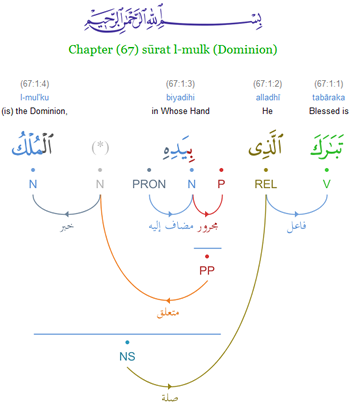_
The grammar section of the website provides a set
of guidelines for annotators who wish to contribute to the project. In
the Quranic Arabic Corpus, the traditional Arabic grammar of iʿrāb (إعراب)
is used to visualize Quranic syntax through the use of dependency graphs. This description of
Quranic grammar is useful for further computational analysis, as well
as for linguists researching the language of the Quran, and for those
with a general interest in the Arabic language. The syntactic treebank contains verses of the
Quran annotated using dependency grammar.
The Syntax of Nominals
The nominals are one of the three basic parts-of-speech according to traditional
grammar. These include nouns, pronouns and adjectives. The following
sections describe the syntax of nominals:
- Gender - semantic, morphemic and grammatical gender
- Adjectives - these follow and depend on the noun that they describe
- Possessives - the possessive construction of iḍāfa (إضافَة) is used with the genitive case
- Apposition - two nouns placed side by side, both with the same syntactic function
- Specification - tamyīz (تمييز) specifies the degree of a head word
- Numbers - the murakkab (مركب) dependency is used to annotate digit compounds
Verbs, Subjects and Objects
The verbs form the second of the three basic parts-of-speech. The following sections describe
the syntax of verbs in the Quran, as well as case rules for subjects
and objects of verbs:
- Verb forms - the different forms of verbs found in Quranic Arabic
- Subjects and objects - these will inflect for different cases according to syntactic function
- The verb kāna (كان واخواتها) - a special group of verbs with different case rules
- Verb moods - the subjunctive and jussive moods of the imperfect (فعل مضارع)
- Imperative verbs - commands, requests and negative prohibitions using the imperfect jussive
Phrases and Clauses
In the Quranic Arabic corpus, phrase nodes are used to
represent phrases and clauses. Traditional Arabic grammar defines a set
of dependencies for different types of phrases and clauses:
- Preposition phrases - these use the genitive case and can attach to nouns or verbs
- Coordinating conjunctions - these connect two words, phrases or clauses (حرف عطف)
- Subordinating conjunctions - together with relative pronouns these introduce subordinate clauses
- Conditional sentences - formed of two clauses, the condition (شرط) and the result (جواب شرط)
Adverbial Expressions
The accusative case ending manṣūb
(منصوب) is used in
various grammatical constructions, which include adverbial expressions
and objects:
- Circumstance - the circumstantial accusative (حال)
- Cognate accusative - the mafʿūl muṭlaq (مفعول مطلق)
- Accusatives of purpose - l-mafʿūl li-aj'lihi (المفعول لأجله)
- Comitative objects - l-mafʿūl maʿahu (المفعول معه)
The Syntax of Particles
The particles are the third of the three basic parts-of-speech. The following annotation
guidelines discuss common syntactic constructions involving particles:
- The particle alif (أ) - interrogative and equalizational uses of hamza
- The particle inna (ان واخواتها) - a special group of particles with their own case rules
- The particle fa (ف) - conjunction, resumption and cause particles
- Vocative particles - these can place a noun into one of two grammatical cases
- Exceptive particles - may place a noun into the accusative case according to the type of exception

No comments:
Post a Comment